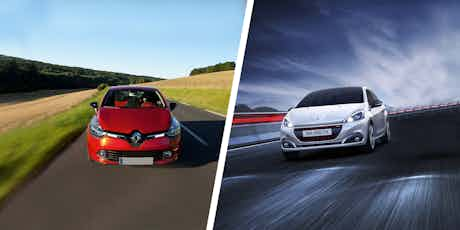Renault Clio vs Peugeot 208: French face-off
June 24, 2015 by carwow staff

The Peugeot 208 and the fourth generation of the Renault Clio remain two of the best small hatchbacks out there. But how do they compare to each other?
We put the recently facelifted Peugeot up against the Clio to see which should end up on your driveway.
Styling

In a segment where cars often look similar, it’s refreshing to see both the Renault and the Peugeot are distinctive enough that it wouldn’t be strain to pick either out of a crowd. The 208 employs the ‘feline’ styling which Peugeot has championed for years and, in it’s latest form, it looks modern, minimalist and classy.
The Clio takes a slightly different approach. The oversized headlights and prominent Renault badge lend it a quirkier look, but one that could never be confused for rivals. The rear lights are slimmer and sharper, and the sides feature sculpted doors to help it stand out.
The Clio is available as a five-door only, while the 208 can be chosen with either three- or five-doors.
Interior

Inside, it’s the 208 which has the more unusual appearance, thanks largely to a smaller diameter steering wheel compared to most cars. Peugeot says this reduces the amount of time the driver diverts their eyes from the road to check the instrument panel. It’s worth checking out before you buy though – some people find that once they’ve got comfortable, the steering wheel obstructs the dials.
The Clio’s cabin is more conventional. The centre console is predominantly finished in piano black plastic to add a feeling of quality, while the rest offers little out of the ordinary.
When it comes to build quality, the 208 gets the nod over the Clio. Peugeot has worked very hard to shake of its reputation of selling cars with flimsy interiors in recent years, and it’s paid off. The 208 might not quite match the quality of a Volkswagen Polo inside, but it isn’t far off.
Front seat occupants are well catered for in both cars, but taller rear seat passengers in the Clio will find headroom just a little tight. While the 208 wins out in this area, the Clio gains points for a slightly larger boot – at 300 litres it’s 15 larger than the Peugeot’s and one of the biggest in the class.
Driving

Both have light steering which makes them easy to drive around town but both cars also suffer from slightly loose-feeling gearboxes.
Out of the two, the Clio seems to be tuned more for comfort, while the 208 focuses more on fun. The Clio’s ride is much smoother (the Peugeot’s borders on the uncomfortable at times), but it does tend to roll a little in the corners.
Engines

The 208 is offered with a choice of petrol and diesel engines. The entry-level 1.0-litre petrol could be just a little too sluggish for some, but it’s very economical, cheap to insure, and road tax is free. Perhaps the highlight of the range is the 1.6-litre diesel. Producing either 92 or 115hp, Peugeot claims it’ll return 74.3mpg. It’s also significantly quieter and smoother than the equivalent unit in the Ford Fiesta.
If economy is a priority, however, the Renault Clio is the one to go for. When fitted with the 90hp 1.5-litre dCi, it’ll return a deeply impressive 83.1mpg. That means with a (very) delicate right foot, you might be able to squeeze almost 900 miles out of a tank of fuel.
The petrol options aren’t particularly groundbreaking, but they’re better choices for those who travel shorter distances. The Clio is also available with a ‘warm’ option: the 120hp, 1.2-litre turbo GT Line model isn’t quite a full blown hot hatch (for that check out the RenaultSport Version, of Peugeot’s equivalent, the 208 GTi), but it still delivers strong performance.
Value for money

The entry level 208 is very competitively priced at £9,995. Very few cars in the class offer any models at less than £11,000 (including the Clio) so for that reason alone, the Peugeot should be well worth a look.
Further up the range, each car is fairly well equipped, with the likes of satellite navigation, LED daytime running lights and cruise control all becoming available the higher you climb. The Renault is generally the cheaper car to insure – excluding the RenaultSport versions, groups range from seven to 14. The 208 starts from a lower group (five) but climbs all the way to 24.
Verdict
Based on our wowscores, the Renault Clio is the one to have out of these two. It narrowly edges the 7.4-rated Peugeot 208 by 0.3 points, thanks mainly to the smoother ride and the potential for very low running costs.
However, there are still plenty of reasons to recommend the 208. It’s a little more roomy than the Clio in the back, feels better built and more refined. Above all, it’s hard to argue with such a low starting price.
So the Clio just wins out here, but both Peugeot and Renault are still producing some of the best superminis around, just as they were over thirty years ago.
What next?
Pop either the Renault Clio or the Peugeot 208 into your car configurator to see how much you could save. For more options, check out our deals page.















